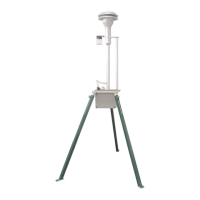Therefore, for Standard Conditions;
760 TI
QI = QS ( ----- x --------- )
PI 293.18
TI
QI = 2.592 QS (----- ) Equation #2
PI
Example 1:
The instrument is being set up to run at 10 Lpm at Standard Conditions with a flow meter. The
ambient conditions in the set up location are 19 degrees Celsius (292.18 degrees Kelvin) and
765 millimeters of Mercury.
Then;
292.18
QI = 2.592 10.0 (---------- ) = 9.899 Liters per minute
765
Therefore, if you set a Target Flow of 10.0 Lpm on the PQ100 and 9.90 Lpm on the flow meter,
you will always be sampling at 10.0 Lpm to Standard Conditions regardless of changes in the
weather (i.e. regardless of changes in air density). At a later date when you wish to check the
calibration, Equation #2 still applies as in Example 2.
Example 2:
The instrument was set as detailed in Example 1. You are now out of doors at a sampling site.
The conditions are TI = 27 degrees Celsius (300.18 degrees Kelvin) and PI = 750 millimeters of
Mercury.
From Equation #2;
300.18
QI = 2.549 10.0 (---------- ) = 10.37 Liters per minute
750
Therefore, if the PQ100 reads 10.00 Lpm and the bubble meter reads 10.37 Lpm the PQ100 is
still in calibration and is sampling 10.0 Lpm at Standard Conditions.

